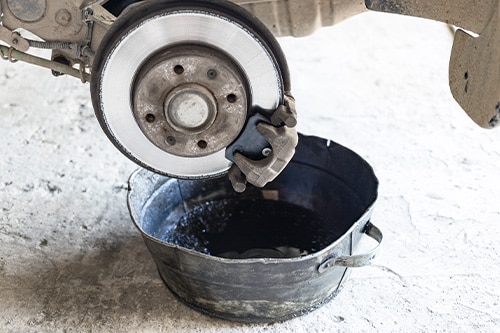The Truth About Brake Flush Flushes: Vital Maintenance or Costly Upsell?

The Problem with Old Brake Fluid
Regular brake fluid is a glycol-based hydraulic fluid specially formulated to work in automotive braking systems. This fluid is designed to handle extreme pressure and heat generated as you hit the brakes. And it’s non-compressible, so it can properly transmit force from the pedal to your brake calipers.
Glycols are an excellent base for brake fluid because they have a high boiling point and exceptional lubricating properties. But there is one downside. Glycols are hygroscopic, which means the fluid absorbs moisture from the air. DOT 3 absorbs up to 2% water per year in humid areas, and DOT 4 absorbs moisture even faster.
Water in the system causes the brake fluid to boil at a much lower temperature than normal. Non-contaminated fluid boils at a temperature of 401°F to 446°F, depending on the formula. With water in the mix, it’ll start boiling at 284°F, causing your rotors and pads to overheat. You’ll also notice that your brake pedal feels soft and spongy as the boiling water allows the fluid to compress.
All this adds up to poor stopping power, especially on long, demanding drives. Worse yet, the contaminated fluid results in corrosion of the parts in your braking system. At best, this may result in having to replace costly brake parts, and at worst, it could cause a serious accident.
How a Brake Fluid Flush Can Help
So, as you can see, water in your braking system is no little thing. Brake fluid needs to remain uncontaminated to keep your car stopping as expected. Fortunately, it’s easy to make that happen. All you need to do is have a brake flush completed as recommended by your trusted mechanic in Canton CT.
To complete this service, an ASE-certified auto tech will fully drain the old fluid out and replace it with the proper brake fluid type for your car. Then, they will remove all the air from the system while continuing to top off the fluid in the master cylinder. Once that’s done, they’ll test drive your car to confirm that the pedal feels good and your car stops on a dime.
With the new fluid in your car, you don’t have to worry about boiling brake fluid, corrosion, and the poor stopping power that results. You can rest assured that your car’s braking parts are well-protected and will work properly when you need them.
Signs You Need a Brake Fluid Flush
Ideally, you should have a brake flush completed before problems arise. Depending on the factory-recommended intervals for your car, you’ll likely need to complete this service once every two years or 30,000 miles.
Your car will likely let you know that it’s time for service if you go any longer than that. The most common signs that you need to bring your car in for service ASAP are:
- Longer stopping distances
- Soft or spongy brake pedal feel
- Dirty or discolored brake fluid
- ABS light turns on
- Burning odors
If you’re unsure when to come in, just consult with your mechanic. They’ll review your car’s service history and perform an inspection to see if it’s time for a brake flush. If so, they’ll let you know their auto repair recommendations and reasoning, so you can make the best care decisions for your car.
Get Proper Care for Your Car at Collinsville Auto Repair
At Collinsville Auto Repair, we want your car to run, drive, and stop at its very best through every mile. That’s why we recommend that you complete all maintenance services, including brake fluid flushes, on the schedule set by your carmaker. Also, take the time to report any issues with your car as they arise, so we can fix them before the problem worsens.
If you’re ready to visit our Certified NAPA AutoCare Center, dial (860) 693-4588 to get in touch with our team. We’ll help you find a convenient time to bring your car by and get quality service from our ASE-certified techs. On the day of your appointment, you can find us at 146 Powder Mill Rd, Collinsville, CT 06019. Need to hit the road while we complete your car maintenance? Just ask about our loaner vehicles.
